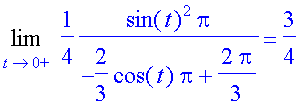The centroid of an ice cream cone (spherical box)
Fix
![]() between 0 and
between 0 and
![]() . We want to compute the centroid of the solid
. We want to compute the centroid of the solid
![]() consisting of all points
consisting of all points
(
![]() ) such that
) such that
![]() is between 0 and 1,
is between 0 and 1,
![]() is between 0 and
is between 0 and
![]() , and
, and
![]() is between 0 and
is between 0 and
![]() . Here is it's picture for
. Here is it's picture for
![phi[0] = Pi/4](images/centroid210.gif) .
.
| > |
| > | icc:=(phi0,n)->display(plot3d(1, t=0..2*Pi, p=0..phi0, coords=spherical, style=wireframe,color=blue),seq(line([0,0,0],[sin(phi0)*cos(2*Pi*i/n),sin(phi0)*sin(2*Pi*i/n),cos(phi0)],thickness=2,color=red),i=1..n),scaling=constrained,axes=normal): |
| > | icc(Pi/4,72); |
![[Maple Plot]](images/centroid211.gif)
By inspection, we can see that the centroid is (0,0,a) where a is somewhere between 0 and 1, depending on
![]() . The volume and moment about the xy-plane can best be evaluated as iterated integrals in spherical coordinates.
. The volume and moment about the xy-plane can best be evaluated as iterated integrals in spherical coordinates.
| > | V := Int(Int(Int(1,z),x=S[phi[0]]..``),y)=Int(Int(Int(1*rho^2*(sin(phi)),rho=0..1),phi=0..phi0),theta=0..2*Pi); |
![V := Int(Int(Int(1,z),x = S[phi[0]] .. ``),y) = Int(Int(Int(rho^2*sin(phi),rho = 0 .. 1),phi = 0 .. phi0),theta = 0 .. 2*Pi)](images/centroid213.gif)
Now the volume of the ice cream cone with cone angle
![]() and cone slant height 1 is
and cone slant height 1 is
| > | V := int(int(int(1*rho^2*(sin(phi)),rho=0..1),phi=0..phi0),theta=0..2*Pi); |

And the moment about the xy plane is
| > |
| > | Mxy := Int(Int(Int(z,z),x=S[phi[0]]..``),y)= Int(Int(Int(rho*cos(phi)*rho^2*sin(phi),rho=0..1),phi=0..phi0),theta=0..2*Pi); |
![Mxy := Int(Int(Int(z,z),x = S[phi[0]] .. ``),y) = Int(Int(Int(rho^3*cos(phi)*sin(phi),rho = 0 .. 1),phi = 0 .. phi0),theta = 0 .. 2*Pi)](images/centroid216.gif)
This evaluates to
| > | Mxy := int(int(int(rho*cos(phi)*rho^2*sin(phi),rho=0..1),phi=0..phi0),theta=0..2*Pi); |

So we can calculate the z-coordinate of the centroid, zbar as
| > | zbar:= unapply(Mxy/V,phi0); |

And for example when the cone angle is 90 degrees, zbar is
| > | simplify(zbar(Pi/4))=evalf(zbar(Pi/4)); |

| > |
(So we did calculate it incorrectly in class as .75)
We can add the centroid to the picture and check to see if it looks reasonable.
| > | picture:= phi0->display(pointplot3d([0,0,evalf(zbar(phi0))],symbol=circle,color=black,thickness=3),icc(phi0,20),scaling=constrained,orientation=[116,80]); |
![]()
![]()
![]()
| > | picture(Pi/4); |
![[Maple Plot]](images/centroid223.gif)
This seems eminately reasonable. Now lets make a movie of the locus of the centroid of the spherical box as phi[0] goes from 0 to Pi.
| > | display(seq(picture(i*Pi/20),i=1..20),scaling=constrained,insequence=true); |
![[Maple Plot]](images/centroid224.gif)
As in the case of the centroid of the pie slice, we see that as
![]() approaches
approaches
![]() , the centroid moves to the center of the ball. At the other extreme (when phi[0] is getting closer to 0, the ice cream cone is approaching a segment (with centroid at the middle of the segment), but the centroid is approaching a number closer to 1 than 0. In the case of the pie slice, this number was 2/3, the limit of the centroid of the triangle approximation to the pie slice. In this case the number is
, the centroid moves to the center of the ball. At the other extreme (when phi[0] is getting closer to 0, the ice cream cone is approaching a segment (with centroid at the middle of the segment), but the centroid is approaching a number closer to 1 than 0. In the case of the pie slice, this number was 2/3, the limit of the centroid of the triangle approximation to the pie slice. In this case the number is
| > | Limit(zbar(t),t=0,right)=limit(zbar(t),t=0,right); |

Question: Why that number? Perhaps if you solve the problem below, you could come up with an explanation.
Problem: Calculate the centroid of the cone of slant height 1 and base radius r.